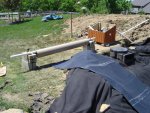Not sure if it's too late to answer the original question about acid wash but at least for other readers...
In my
pool conversion I had 4' straight sides which I mortared rock over the liner. Dry stack isn't really doable for straight sides. You really need a wider base, which means more rocks and the sides don't end up straight.
Because you're in a freezing climate I would only mortar up to the expected freeze depth. The top part can be covered by
hanging cap rocks that you make. You can flip the cap rocks out of the pond for the winter if you like. Either way freezing may push the hanging cap rocks out but no harm. If you mortar all the way to the top ice might push the wall over. I'm saying "might". It takes special conditions, certain freeze thaw cycles have to build enough. Given a choice I would slope the sides a least a few degrees. Even a couple of degrees means the top would have to push out a foot to fall over and critters still couldn't "walk" down that steep a wall.
To your question...
Acid wash is done using diluted muric acid in a garden sprayer. How diluted is kind of up to you. It's serious stuff. You know when someone says "I don't need all that safety crap" when doing something for the first time? This isn't the time for that. Rubber gloves, eye protection, skin covered, not in wind, have a hose and baking soda ready. And it causes flumes that will burn your nose and throat, even cause you to pass out when down inside a pond.
You asked how, that's how. The real question is should you? 10-15 years ago people in pond forums considered concrete poison to fish as they claimed it would raise pH to high level. I believed it for awhile. It was my
first pond myth. I spent the better part of two years trying to convince people it was all a myth. Nice to see that myth seems to have gone away, although I can claim no credit. I quit the forums as it seemed impossible to dispel any myth.
Any who, one of the ways claimed to make concrete "less of a poison" was to do an acid wash. The opposite is actually true. Cement reacts at the surface with air and water to form a layer of calcium carbonite. This layer protects the cement beneath. It's why concrete is very slow (century type scale) to dissolve in water. Acid washes remove the calcium carbonite exposing fresh new cement. This is why many processes that require a bond to concrete require an acid wash.
There are a couple of reasons to acid wash mortared rock. The most common reason is to remove cement residue from the rock. Makes the rock nice and bright. Another reason is to expose the sand in the mortar at the surface. Purely aesthetic to get an aged look.
For rocks in a pond nether of these reasons apply IMO. Unless maybe you didn't clean the rocks as you went. But a little cement film isn't going to be noticed underwater.
BTW...I like mortared rock a lot. Easy to clean. Stays where I put it. And it isn't really very difficult to break up and redo, it's just mortar. Cleaning foam off rock...that's a job.


